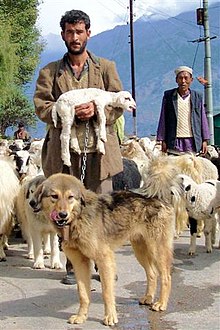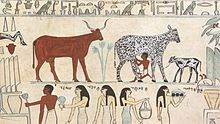馴化

馴化是指一種生物的成長與生殖逐漸受另一種生物利用與掌控的過程,例如人類栽培各種農作物、畜牧,以及切葉蟻馴養真菌。人類馴化動植物的目的主要包括作為食物和衣物的來源、運輸、守衛或是觀賞娛樂用途。馴化被認為是人類文明起源的里程碑事件[1],自進入全新世後總共約有2500個物種受到過人類馴化, 約250個物種被認為進行了完全馴化[1]。
人類馴化植物至少在1萬2千年前就開始了,例如穀物和葫蘆,獨立的動植物馴化事件至少發生在美洲、西南亞、南亞、東亞等11個地區[2]。人類最早的農耕文明美索不達米亞文明在距今至少一萬年前就種植了豌豆、亞麻、鷹嘴豆、小麥和大麥等;中國獨立馴化了豬、黍、粟、大豆和稻米等[3]。人類馴養的常見動物包括了提供物質價值的家畜、家禽和養殖水產,以及提供情感價值的寵物和觀賞魚。最先被人類馴化的動物是由灰狼演化出的狗,在新石器革命後在美索不達米亞馴化的山羊、綿羊、家牛等傳播到了各個大洲[4];南美大陸的美洲駝和羊駝被馴化用於肉食、駝役和生產駝毛製品[5]。
動物[編輯]
起源[編輯]

末次盛冰期結束後大規模的動物馴化在全新世爆發,推動了人類社會在新石器時代的快速發展[6]。除了最早被人類馴化的動物狗(由灰狼(Canis lupus)馴化[7])外,其他馴化動物都是伴隨着農業文明的發展逐漸馴化[2]。
動物馴化形成了一種長期的互惠關係:馴化者為被馴化動物提供庇護, 被馴化動物為馴化者提供穩定的產品和便利, 馴化雙方在整個過程中都增加了生存適應性[8]。馴化後的動物為人類提供了肉食、服飾和生產力等[2]。
動物能否被成功馴化雖然環境是重要條件,但動物本身的特性更為重要(例如近東地區的瞪羚和非洲的斑馬就因為動物本身的特性不適合馴化,而至今未能馴化成功)[9]。總體而言,能成功馴化的動物仍然是少數[10]。
普遍認為,適合馴養的動物應具有以下特點[2]:
| 物種 | 野生祖先 | 年代 | 地區 |
|---|---|---|---|
| 狗 (Canis lupus familiaris) | 公元前15000年 [11] | 東亞和非洲 | |
| 綿羊 (Ovis orientalis aries) | 亞洲盤羊(O. orientalis) | 公元前9000-11000年[12][13] | 西南亞 |
| 山羊 (Capra aegagrus hircus) | 野山羊(C. aegagrus) | 公元前10000年 [14] | 伊朗 |
| 豬 (Sus scrofa domestica) | 歐亞野豬(S. scrofa) | 公元前9000年[15] | 近東、中國 |
| 牛 (Bos primigenius taurus) | 公元前8000年[16][17] | 印度、中東和撒哈拉以南非洲 | |
| 貓 (Felis catus) | 公元前7500年 [18][19][20][21][22] | 塞浦路斯和近東 | |
| 雞 (Gallus gallus domesticus) | 紅原雞(G. gallus) | 公元前6000年[23] | 印度和東南亞 |
| 豚鼠 (Cavia porcellus) | 公元前5000年[24] | 秘魯 | |
| 驢 (Equus africanus asinus) | 非洲野驢(E. africanus) | 公元前5000年[25][26] | 埃及 |
| 家鴨 (Anas platyrhynchos domesticus) | 綠頭鴨(A. platyrhynchos) | 公元前4000年 | 中國 |
| 水牛 (Bubalus bubalis) | 野水牛(B. arnee) | 公元前4000年 | 印度, 中國 |
| 馬 (Equus ferus caballus) | 野馬(E. ferus) | 公元前4000年[27] | 歐亞草原 |
| 單峰駱駝 (Camelus dromedarius) | 公元前4000年 | 阿拉伯 | |
| 大羊駝 (Lama glama) | 原駝(L. guanicoe) | 公元前3500年 | 秘魯 |
| 蠶 (Bombyx mori) | 公元前3000年 | 中國,參見:蠶業。 | |
| 馴鹿 (Rangifer tarandus) | 公元前3000年[28] | 俄羅斯 | |
| 野鴿 (Columba livia) | 公元前3000年 | 地中海盤地 | |
| 鵝 (Anser anser domesticus) | 公元前3000年[29] | 埃及 | |
| 雙峰駱駝 (Camelus bactrianus) | 公元前2500年 | 中亞 | |
| 氂牛 (Bos grunniens) | 公元前2500年 | 中國西藏 | |
| 爪哇野牛 (Bos javanicus) | 未知 | 東南亞、爪哇島 | |
| 大額牛 (Bos gaurus frontalis) | 未知 | 東南亞 | |
| 羊駝 (Vicugna pacos) | 原駝(L. guanicoe) | 公元前1500年 | 秘魯 |
| 雪貂 (Mustela putorius furo) | 公元前1500年- | 歐洲 | |
| 番鴨 (Cairina momelanotus) | 未知 | 南美洲 | |
| 珍珠雞 | 未知 | 非洲 | |
| 鯉魚 | 未知 | 東亞 | |
| 家養火雞 | 公元前500年 | 墨西哥 | |
| 金魚 | 未知 | 中國 | |
| 穴兔 | 公元前1600年 | 歐洲 | |
| 瘤牛 (Bos primigenius indicus) | 原牛印度亞種 | 公元前8000年 | 印度 |
| 蜜蜂 | 公元前4000年 | 多個地區,參見:蜜蜂養殖。 |
馴化的方式[編輯]
人類最初因喜愛動物而對其進行飼養並建立了親密關係[2]。如今廣為接受的馴化方式是共生、獵食和定向[30]。在共生方式中,野生動物被食物殘渣、污穢物吸引,主動接近人類並逐漸與人類建立了雙向的夥伴關係,例如最早被馴化的狗;在捕獵方式中,人類初期直接殺死捕獲的野生動物,而後人們選擇相對溫順的動物進行繁殖,例如豬的馴化;定向方式是在人們已經掌握了一定馴化經驗之後,具有明確目的的馴化,例如馬、駱駝等[2]。
擴散及育種[編輯]
馴化的動物隨着人類的戰爭、遷徙、人口擴張等逐步擴散到世界各地[2]。在此過程中,馴化的動物經歷了種群內近交、基因漂變、優勢性狀自然選擇、選擇鬆弛以及人工選育5個階段[6]。現代隨着基因組技術的發展, 大大縮短了馴化動物雜交育種的時間[31]。
現代馴化的實例[編輯]
| 物種 | 年代 | 地區 |
|---|---|---|
| 大鼠 | 1800s | 英國 |
| 狐狸 | 1800s | 歐洲 |
| 水貂 | 1800s | 歐洲 |
| 虎皮鸚鵡 | 1850s | 歐洲 |
| 雞尾鸚鵡 | 1870s | 歐洲 |
| 斑胸草雀 | 1900s | 澳大利亞 |
| 倉鼠 | 1930s | 美國 |
| 銀狐 | 1950s | 蘇聯 |
| 麝牛 | 1960s | 美國 |
| 粟米蛇 | 1960s | 美國 |
| 球蟒 | 1960s | |
| 馬達加斯加蟑螂 | 1960s | |
| 馬鹿 | 1970s | 新西蘭 |
| 刺蝟 | 1980s | 美國 |
| 蜜袋鼯 | 1980s | 澳大利亞 |
| 臭鼬 | 1980s | 美國 |
| 蜜熊 | 年代不確定 | 中美洲 |
| 部分寄生蜂 | 年代不確定 |
植物[編輯]
最初的動物馴化影響最大的是控制動物行為的基因,而最初的植物馴化影響的是控制植物形態的基因(種子大小、植物結構、傳播機制)以及生理機能(發芽或成熟的時間)。[32][33]

其他[編輯]
用來釀酒的酵母菌和食用真菌等等也是人類馴化後的結果。
參見[編輯]
參考文獻[編輯]
- ^ 1.0 1.1 Meyer, Rachel S.; Purugganan, Michael D. Evolution of crop species: genetics of domestication and diversification. Nature Reviews Genetics. 2013-12, 14 (12): 840–852. doi:10.1038/nrg3605.
- ^ 2.0 2.1 2.2 2.3 2.4 2.5 2.6 Cai, Xinyu; Mao, Xiaowei; Zhao, Yiqiang. Methods and research progress on the origin of animal domestication. Biodiversity Science. 2022-04-20, 30 (4): 21457. doi:10.17520/biods.2021457.
- ^ Larson, Greger; Piperno, Dolores R.; Allaby, Robin G.; Purugganan, Michael D.; Andersson, Leif; Arroyo-Kalin, Manuel; Barton, Loukas; Climer Vigueira, Cynthia; Denham, Tim; Dobney, Keith; Doust, Andrew N.; Gepts, Paul; Gilbert, M. Thomas P.; Gremillion, Kristen J.; Lucas, Leilani; Lukens, Lewis; Marshall, Fiona B.; Olsen, Kenneth M.; Pires, J. Chris; Richerson, Peter J.; Rubio de Casas, Rafael; Sanjur, Oris I.; Thomas, Mark G.; Fuller, Dorian Q. Current perspectives and the future of domestication studies. Proceedings of the National Academy of Sciences. 2014-04-29, 111 (17): 6139–6146. doi:10.1073/pnas.1323964111.
- ^ Brown, Terence A.; Jones, Martin K.; Powell, Wayne; Allaby, Robin G. The complex origins of domesticated crops in the Fertile Crescent. Trends in Ecology & Evolution. 2009-02, 24 (2): 103–109. doi:10.1016/j.tree.2008.09.008.
- ^ Wing, Elizabeth S. Animal Domestication in the Andes. Advances in Andean Archaeology. 1978-12-31: 167–188. doi:10.1515/9783110810011.167.
- ^ 6.0 6.1 Teletchea, Fabrice. Animal Domestication: A Brief Overview. Animal Domestication. 2019-07-17. doi:10.5772/intechopen.86783.
- ^ Boyko, AR; Boyko, RH; Boyko, CM; Parker, HG; Castelhano, M; Corey, L; Degenhardt, JD; Auton, A; Hedimbi, M; Kityo, R; Ostrander, EA; Schoenebeck, J; Todhunter, RJ; Jones, P; Bustamante, CD. Complex population structure in African village dogs and its implications for inferring dog domestication history.. Proceedings of the National Academy of Sciences of the United States of America. 2009-08-18, 106 (33): 13903–8. PMID 19666600. doi:10.1073/pnas.0902129106.
- ^ Zeder, Melinda A. Core questions in domestication research. Proceedings of the National Academy of Sciences. 2015-03-17, 112 (11): 3191–3198. doi:10.1073/pnas.1501711112.
- ^ Diamond, Jared. Evolution, consequences and future of plant and animal domestication. Nature. 2002-08, 418 (6898): 700–707. doi:10.1038/nature01019.
- ^ Losey, Robert J. Domestication is not an ancient moment of selection for prosociality: Insights from dogs and modern humans. Journal of Social Archaeology. 2022-06, 22 (2): 131–148. doi:10.1177/14696053211055475.
- ^ See Origin of the domestic dog
- ^ Krebs, Robert E. & Carolyn A. Groundbreaking Scientific Experiments, Inventions & Discoveries of the Ancient World. Westport, CT: Greenwood Press. 2003. ISBN 0-313-31342-3.
- ^ Simmons, Paula; Carol Ekarius. Storey's Guide to Raising Sheep. North Adams, MA: Storey Publishing LLC. 2001. ISBN 978-1-58017-262-2.
- ^ Melinda A. Zeder, Goat busters track domestication (頁面存檔備份,存於網際網路檔案館) (Physiologic changes and evolution of goats into a domesticated animal), April 2000, (英文).
- ^ Giuffra E, Kijas JM, Amarger V, Carlborg O, Jeon JT, Andersson L. The origin of the domestic pig: independent domestication and subsequent introgression., April 2000, (英文).
- ^ Late Neolithic megalithic structures at Nabta Playa (Sahara), southwestern Egypt. 網際網路檔案館的存檔,存檔日期2008-02-13.
- ^ Source : Laboratoire de Préhistoire et Protohistoire de l'Ouest de la France 存档副本. [2009-04-17]. (原始內容存檔於2009-06-26)., (法文).
- ^ Oldest Known Pet Cat? 9500-Year-Old Burial Found on Cyprus. National Geographic News. 2004-04-08 [2007-03-06]. (原始內容存檔於2015-11-27).
- ^ Muir, Hazel. Ancient remains could be oldest pet cat. New Scientist. 2004-04-08 [2007-11-23]. (原始內容存檔於2014-10-16).
- ^ Walton, Marsha. Ancient burial looks like human and pet cat. CNN. April 9, 2004 [2007-11-23]. (原始內容存檔於2007-12-22).
- ^ [1] (頁面存檔備份,存於網際網路檔案館), domestication of the cat on Cyprus, National Geographic.
- ^ Feline genetics help pinpoint first-ever domestication of cats, MU study finds // Show Me Mizzou // University of Missouri. showme.missouri.edu. [2023-01-03]. (原始內容存檔於2023-01-03) (美國英語).
- ^ West B. and Zhou, B-X., Did chickens go north? New evidence for domestication, World’s Poultry Science Journal, 45, 205-218, 1989, quotationPDF (26.3 KiB), 8 p. (英文).
- ^ History of the Guinea Pig (Cavia porcellus) in South America, a summary of the current state of knowledge. [2010-05-27]. (原始內容存檔於2011-10-09).
- ^ Beja-Pereira, Albano et al., African Origins of the Domestic Donkey, Science 304:1781, 18 June 2004, cited in New Scientist (頁面存檔備份,存於網際網路檔案館), (英文).
- ^ Roger Blench, The history and spread of donkeys in AfricaPDF (235 KiB) (英文).
- ^ The Domestication of the Horse 網際網路檔案館的存檔,存檔日期2007-02-02.; see also Domestication of the horse
- ^ Domestication of Reindeer 網際網路檔案館的存檔,存檔日期2009-03-16.
- ^ Geese: the underestimated species. [2010-05-27]. (原始內容存檔於2017-07-27).
- ^ Zeder, Melinda A. The Domestication of Animals. Journal of Anthropological Research. 2012-06, 68 (2): 161–190. doi:10.3998/jar.0521004.0068.201.
- ^ Bosse, Mirte. A Genomics Perspective on Pig Domestication. Animal Domestication. 2019-07-17. doi:10.5772/intechopen.82646.
- ^ Zeder MA. The domestication of animals. Journal of Anthropological Research. 2012, 68 (2): 161–190. doi:10.3998/jar.0521004.0068.201.
- ^ Zeder MA. 2006. Archaeological approaches to documenting animal domestication. In Documenting Domestication: New Genetic and Archaeological Paradigms, ed. M Zeder, DG Bradley, E Emshwiller, BD Smith, pp. 209–27. Berkeley: Univ. Calif. Press
外部連結[編輯]
- Discussion of animal domestication (頁面存檔備份,存於網際網路檔案館)
- Guns, Germs and Steel by Jared Diamond (ISBN 0-393-03891-2)
- News story about an early domesticated cat find
- Belyaev experiment (頁面存檔備份,存於網際網路檔案館) with the domestic fox
- Use of Domestic Animals in Zoo Education (頁面存檔備份,存於網際網路檔案館)
- The Initial Domestication of Cucurbita pepo in the Americas 10,000 Years Ago (頁面存檔備份,存於網際網路檔案館)
- Phytolith evidence for early Holocene Cucurbita domestication in southwest Ecuador
- An Asian origin for a 10,000-year-old domesticated plant in the Americas
| ||||||||||||
